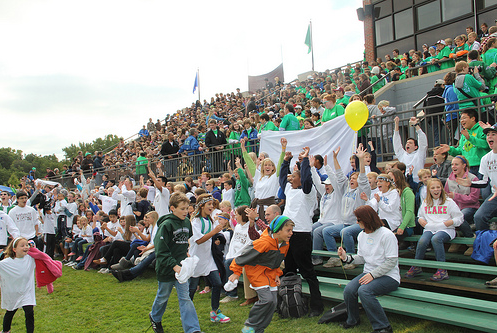Legacy Day: Is there room for improvement?
How much did you enjoy Legacy Day? Was this day of service meaningful to you? These questions were asked on a survey delivered to members of the Blake community. Out of the 117 students who responded to the survey, 35% said they enjoyed Legacy Day a great deal, 50% of them reported they somewhat enjoyed it and 15% communicated they didn’t enjoy this day at all.
Before diving into the current issues of Legacy Day, here’s some history. Legacy Day was founded by Mr. Bogursky and former teacher Sarah Stevenson. Stevenson’s former school has a day very similar to Legacy Day. Nine years ago Stevenson and Bogursky suggested that Blake should create something like this to add to convocation. Legacy Day has been here ever since. Legacy Day is a great event in terms of bringing all grades and campuses together around a good cause that embodies years of tradition. However, many members of the Blake community agree that this day could be revised to be a more meaningful and enjoyable experience for all students.
Although only 15% of the people who responded to the survey state that they didn’t enjoy Legacy Day at all, 17% of Upper School students neglected to show up. This is ninety-one individuals. Although some students were actually out sick on this day, many were not. On average, thirty students miss school on any given day. Why aren’t these students making an appearance on Legacy Day? Why are three times as many kids missing on Legacy Day than any other given day? Perhaps they feel as if they have more important things to do on this day and see it as a great opportunity to call in sick. What does this say about Legacy Day? Is the service not meaningful enough? When asked about this problem Dion Crushshon states, “It’s unfortunate [when older students don’t show up] because it breaks down the whole model”.
Although not all students at the Upper School attended Middle School at Blake, many did. Dion realizes that it’s understandable to have the mentality that Legacy Day is the same-every single year and for students to have a “been there, done that” attitude. However, Dion urges Upper School students to think from a new perspective: remember what Legacy Day meant to you when you were younger. If we enjoy memories of sitting on that senior’s shoulders or playing tag with that older student, Dion believes we owe it to the present generation of younger kids to provide the same experience so many upper school students enjoyed when they were younger.
In order for students to feel their attendance is important at Legacy Day, faculty must lead by simply showing up. This year thirty employees, including faculty as well as those involved in Admissions, Transportation, and Institutional Advancement, were absent on this day. Although some faculty members had legitimate reasons for missing such as traveling to a wedding or attending a family member’s art opening, many did not. How can we as a community expect students to attend Legacy Day if our adults are excusing themselves from this day?
Why should students and adults feel inclined to show up in the service does not seem meaningful? For those of you who don’t know, there was an armadillo at Legacy Day. A representative from one of the organizations was unable to make an appearance on Legacy Day. This created a hole in the schedule and what better way to fill this hole than bringing a zoo to school. Although, Bogursky had no involvement in the decision to bring the Minnesota Zoo to Legacy Day and didn’t know about it was happening until after the fact, he remarked, “Animals are always a hit! That was definitely a throwaway. There was no attempt to tie that into service, because there was none.” Graybeal and Mr. Rathmann decided to invite the Minnesota Zoo to Legacy Day because, “Our partner organization for the Mommy Packs was unable to spare a visiting volunteer for the day. When we used to build the nesting boxes, the visiting raptors were always a hit, so Mr. Rathmann and I decided that the presentation time for the Mommy Pack groups could be matched pretty effectively with the MN Zoo. And after all, who didn’t love the armadillo?” Although this activity may have been entertaining, it didn’t further Legacy Day’s meaning and perhaps exemplifies why many excuse themselves on this day because they feel as if they’re not doing meaningful service.
Many students and faculty in the Blake community agree that improvements must be made. When asked how we could better Legacy Day, Anne Graybeal stated, “I think it’s incumbent on us to better frame for our community why we would do service on a day we’re all coming together. What does this signify? It doesn’t mean that Blake is saving the world or saving the Twin Cities in single day. Why is it meaningful for us to make that choice? If we could do a better job at articulating that rationale, I think it would improve for some people.”
A common idea in the survey responses was that there was a very small amount of time actually doing service compared to the time that was taken talking about doing it. One student who didn’t enjoy Legacy Day reports, “I feel like 5% of the day is actually spent doing service and the other 95% is a waste of time.” Many other students note that this day “could’ve been more productive” or insist that “ [we should] do actual service.”
The majority of students think that the most effective way to improve Legacy Day is to spend more time actually working on service projects. One student even wrote that it would be beneficial to have it more than once a year. This would allow the entire Blake community to form a long lasting and trustworthy relationship with the organizations they chose to partner with.
Blake’s Legacy Day needs to be improved if we are to help people in need become self-sufficient. One student commented that most of the items in the bags made for mothers in need were “disposables and were not a long term solution for a poor mother who needs to get working so as to have the money to support herself and her child.” This student went on to suggest, “we should support them by giving them certain essential long term use items.” Although sometimes it is critical to send immediate aid, this is not always the best way to go about service. Crushshon describes that immediate aid was heavily needed after the horrific earthquake in Haiti, therefore, the 2010 Legacy Day was focused on providing Haitians with the aid they needed. However, when there is no devastating crisis occurring, Crushshon states that a sustainable approach to the problem would be more meaningful.
 Blake photo
Blake photo
When asked about what the school can do to make improvements for Legacy Day, Bogursky pointed out that any real change will need to be initiated by students. For people who have suggestions or want to get involved in strengthening the Legacy Day experience, please contact your grade dean.

Julia has been a Staff Writer since her freshman year. She was Spectrum's Online Editor as a Junior. She enjoys traveling, reading, playing sports,...








